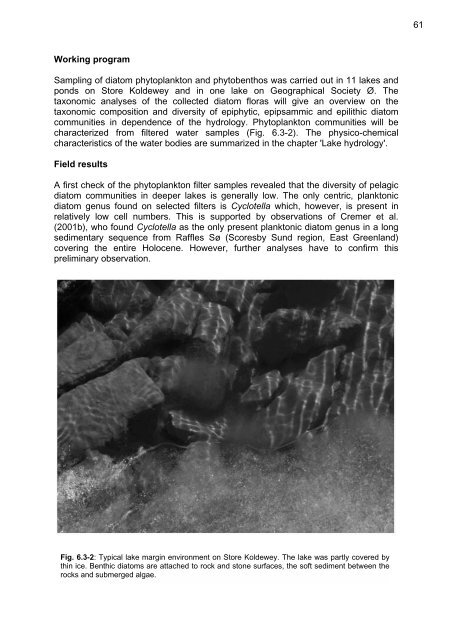the Expedition ARKTIS-XIX/4 of the research vessel POLARSTERN ...
the Expedition ARKTIS-XIX/4 of the research vessel POLARSTERN ...
the Expedition ARKTIS-XIX/4 of the research vessel POLARSTERN ...
Create successful ePaper yourself
Turn your PDF publications into a flip-book with our unique Google optimized e-Paper software.
Working program<br />
Sampling <strong>of</strong> diatom phytoplankton and phytobenthos was carried out in 11 lakes and<br />
ponds on Store Koldewey and in one lake on Geographical Society Ø. The<br />
taxonomic analyses <strong>of</strong> <strong>the</strong> collected diatom floras will give an overview on <strong>the</strong><br />
taxonomic composition and diversity <strong>of</strong> epiphytic, epipsammic and epilithic diatom<br />
communities in dependence <strong>of</strong> <strong>the</strong> hydrology. Phytoplankton communities will be<br />
characterized from filtered water samples (Fig. 6.3-2). The physico-chemical<br />
characteristics <strong>of</strong> <strong>the</strong> water bodies are summarized in <strong>the</strong> chapter 'Lake hydrology'.<br />
Field results<br />
A first check <strong>of</strong> <strong>the</strong> phytoplankton filter samples revealed that <strong>the</strong> diversity <strong>of</strong> pelagic<br />
diatom communities in deeper lakes is generally low. The only centric, planktonic<br />
diatom genus found on selected filters is Cyclotella which, however, is present in<br />
relatively low cell numbers. This is supported by observations <strong>of</strong> Cremer et al.<br />
(2001b), who found Cyclotella as <strong>the</strong> only present planktonic diatom genus in a long<br />
sedimentary sequence from Raffles Sø (Scoresby Sund region, East Greenland)<br />
covering <strong>the</strong> entire Holocene. However, fur<strong>the</strong>r analyses have to confirm this<br />
preliminary observation.<br />
Fig. 6.3-2: Typical lake margin environment on Store Koldewey. The lake was partly covered by<br />
thin ice. Benthic diatoms are attached to rock and stone surfaces, <strong>the</strong> s<strong>of</strong>t sediment between <strong>the</strong><br />
rocks and submerged algae.<br />
61

















